A Day in the Life of an Interpower Molder
Posted on 12/20/23 2:13 PM
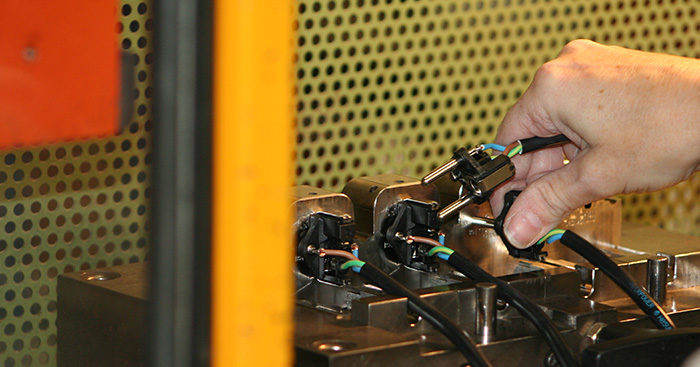
At 7 a.m., Jess, an Interpower Level 2 molder, prepares the ENGEL injection molding machine to mold Continental European (CEE) Cord sets. The CEE plugs will be molded onto 1 mm² international cable, and Jess checks to make sure the 100-lb. CEE mold and proper steel inserts are in place. An additional team member verifies that the correct mold inserts are in place.
The engraved solid steel inserts are small but important to the plug and other components. The ½” x ½” inserts bear testing agency approvals in logos of various scripts and fonts which may reside inside circles, ovals, triangles, rectangles—most of which could easily fit inside a thumbtack. The logos, e.g., UL, CSA, VDE, are marked on the plug, as well as the amperage, the maker’s mark, neutral, line, and ground designations, and the week, month, and year the plug was made—whatever is required by the approval agencies to go onto the product. Markings will vary since Interpower manufactures an array of approved North American and international cord sets and components.
| “We make sure the right molds match up with the right inserts,” Jess said. She continues through her pre-mold progression: the machine’s oil pressure, its temperature settings, the correct color of the resin that’s loaded in the machine. The heated resin will leave the machine’s nozzle injecting the mold upwards of 350°F. Though the PVC plug molds cool quickly, they are often left in the molds for 45 seconds. |
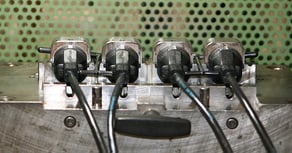
|
Unlike most power cord set manufacturers, Interpower may change out 35-45 100-lb molds per week.
Interpower’s Vice President of Manufacturing and Logistics, Mike Boyle: “We offer 1-week lead-times on custom orders, and same day shipping on in-stock items. We have both large and small orders come in—it’s common for us to change out 40 molds per week.
“We can do this because of our customized quick-change mold process using spring-loaded washers and quick-disconnect water lines. Other molders may have to unbolt the entire mold, which is a far more labor-intensive and time-consuming process. Our quick-change mold process plays a major role in offering our unique 1-week lead-times on custom orders, and same day shipping on in-stock products. By changing molds and colors on the fly, we can keep diversifying our product line.”
| The heavy molds are changed quickly, but safely. When it’s time to change molds, a cart is rolled up to the machine so molders don’t have to lift them out—they just slide them onto the cart which sits at the same level as the mold which limits its travel. |
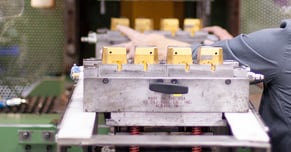
|
| The resin, whether the same or different color, can also be changed quickly by changing a large box where a vacuum tube sends the resin to the molding machine, or by loading it manually into the machine’s hopper. |
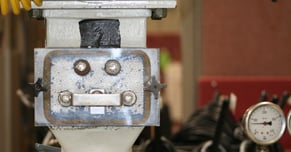
|
| Back at the molder, Jess prepares to test mold a few CEEs. At the front of the machine near the mold is a built-in air hose. “Before I do a test mold,” Jess said, “I blow out the mold cavities to ensure there isn’t any dirt or metal shavings that will affect the molding process.” Standing next to her on wheels is a steel “tree” of jacketed cords containing international 3-conductor 1 mm² wire. The jacketed cord awaits the molded plug. The top of the tree rotates like a wheel, and has 12 sturdy hooks that each hold eight cords. |
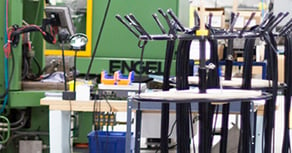
|
The CEE plug is “bridged.” The CEE bridge is a resinous frame with two metal terminals/pins, a flat metal strip along the top and bottom that act as grounding clips, and a female receptacle that will fit a French/Belgian socket pin if needed. The bridge is the part where the CEE plug molds onto.
| “I immediately look for any burns, extra material, or shrinkage.” After a nod of approval, she loops the cords back around the tree, keeping them separate from those remaining to be molded. Once the tree is full of molded cords, she will wheel it down to another cell that molds IEC 60320 connectors on the end opposite the CEE plug, or to the testing station where the cord will undergo hipot and electrical continuity tests—the customer may prefer the opposite end of the cord to be unterminated as to rewire it directly to a machine. |
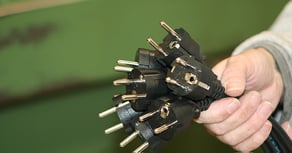
|
“While the machines are always ready to mold at 7 a.m.,” Jess said, “other processes may take priority. This could be anything from crimping or cutting cords to testing—whatever we need to do, we do.”
The Continental European cords are just a fraction of Interpower’s North American and international cord and component offerings. Interpower specializes in making country-specific electrical power cords, cord sets, and components. But the company’s par excellence is built on flexibility, its agility to quick-change mold whether the order is North American or international.
“It all goes back to our flexibility, and our employee cross-training,” Boyle said. “Sure, we can do long runs of the same cord, but customers know we can do short runs, customized runs, and do them fast. It all goes back to our unique 1-week lead-times on custom orders, and our same day shipping on in-stock orders.”
Topics: power cord, power cord made to order, international power components, product development, manufacturing, product information, molding





